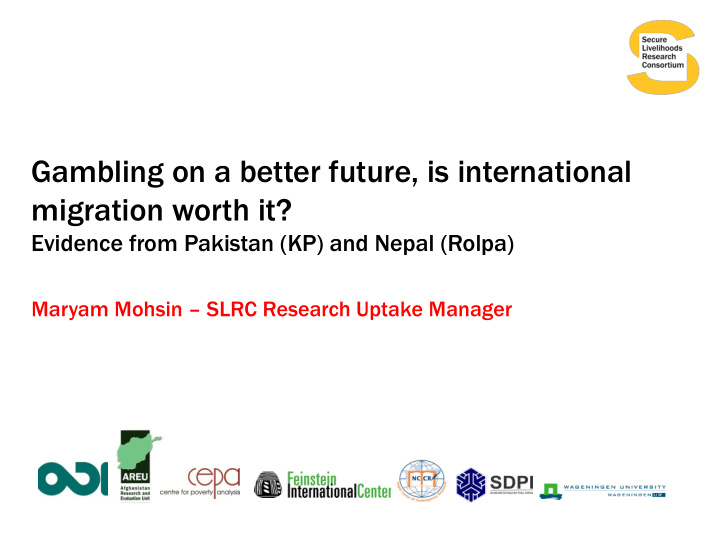



Gambling on a better future, is international migration worth it? Evidence from Pakistan (KP) and Nepal (Rolpa) Maryam Mohsin – SLRC Research Uptake Manager
Why international migration? Background to the research Study relates to SLRC’s research looking at whether peoples livelihoods get better or worse over time in conflict affected situations Migration can bring huge economic returns for migrants and their families and it is a major livelihood strategy in our survey areas 4,000 migrants have died whilst crossing (ILO) international borders in 2014 alone But our research shows that these risks are not confined to transit or the foreign workplace. Often, they start at home. 2
What did we do? Methods and questions Mixed methods: Quantitative (survey – 3176 households in Nepal, 2114 households in Pakistan in 2012) Qualitative in 2013 (51 interviews in each country) Questions: Why and how migration happens in conflict-affected situations What means for migrants and their families livelihoods recovery following a crisis What migration tells us about whether State and aid agencies shape the livelihood trajectories of people emerging from conflict. 3
What did we find? Migration is inevitable for some… Lack of jobs in remote rural areas makes migration inevitable Family history of migration – what % has a migrant in the household? … but not others : Poorest households can’t afford to migrate Labour migration is deeply gendered 4
From one country to the next Costs and migration middle-men Costs Average migration loans amount to 97% of annual household expenditure in Rolpa Aspiring migrants borrow from social networks rather than banks Often long waiting times for passport applications (can be 6-12 months) Middle-men Exploitation and poor information Poor regulation by the State 5
The realities of working abroad What happens when they arrive? Migrants mainly work in three sectors: construction, manufacturing, and hotels/catering Working days are long, temperatures high, breaks infrequent, and safety measures aren't in place. Migrants often don’t receive full wage; delays in payment; or not paid at all Most migrants send home around 50-75% of their income High loans can mean they have to stay longer Vulnerable to exploitation by employer because of dependency on employment, accommodation, food and healthcare Limited support from home State to migrants when they face difficulties 6
What happens to the families left behind? Food security and shifting roles In Pakistan, over 80% of respondents from households with a migrant felt that remittances helped In Nepal, 18% of respondents from households with a migrant found remittances too small to make a difference – 50% said it helped a bit Food security and dietary diversity better in KP thanks to remittances, but not in Rolpa Changes in household structure has direct impacts on the household Increased workload for many household o members staying behind Harder to secure children’s admission to schools o Mobility of female members of household o restricted (Pakistan sample) 7
What needs to be done? Conclusions and policy recommendations 1. Invest in local employment and markets 2. Explore ways to reduce the costs involved with migration 3. Enforce existing regulation 4. Better access to information 8
Read the report on our website: www.securelivelihoods.org Follow: @SLRCtweet Contact: slrc@odi.org.uk
Recommend
More recommend